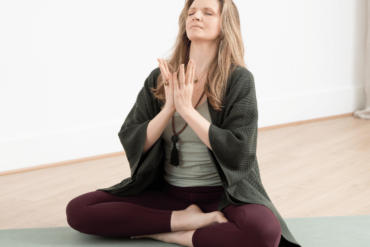Zephyr Wildman is a seasoned Yoga teacher deeply committed to fostering holistic well-being and self-discovery through the transformative practice of yoga. With over 25 years of teaching and study, she specialises in Yoga anatomy, physiology, and biomechanics, as well as Yoga philosophy applied to practice.
Zephyr shares 5 poses for embracing the sacredness within…
Maha Mudra – Janu Sirsasana or Paschimottanasana
One of my favourite Mudras that I weave into my yoga practice is Maha Mudra. Often referred to as the “Great Seal” in yoga, Maha Mudra is a potent technique that integrates physical postures (asanas), breath control (kumbhaka), and energy locks (bandhas) to direct vital energy (prana) to a desired area, intention, or state. This practice promotes physical, mental and spiritual well-being by stimulating, containing and directing prana to enhance mental clarity, concentration and a state of calm serenity leading to contentment.
According to the Tantric text Gheranda Samhita, there are five stages of working with prana:
Activation of Prana
Churning of Prana
Consolidation of Prana
Ignition of Prana
Directing Prana to the desired intention
Maha Mudra can be practiced in seated poses such as Janu Sirsasana, Uttanasana, Paschimottanasana, and any of the seated cross-legged positions like Sukhasana. My favorite, which I regularly use in my teachings, is performing it in Adho Mukha Svanasana.
I enjoy practicing this Mudra by performing a stimulating Pranayama beforehand, such as Kapalabhati, Bhastrika, Surya, or Chandra Bhedana, to activate prana. Depending on my intention, I either perform Antara Kumbhaka (retaining on the inhale) or Bahya Kumbhaka (retaining on the exhale). These two holds create a backdrop for directing prana. Holding the inhale (Antara Kumbhaka) feels like bathing in an illuminated fullness, providing space to enliven, invigorate and excite my focus. Holding the exhale (Bahya Kumbhaka) creates an illuminated emptiness, offering stillness, quietude and profound calm to direct my attention to.
To create the desired ‘seal,’ all three bandhas must be engaged. Maha Bandha, the ‘great bandha,’ involves Mula Bandha (pelvic floor lift), Uddiyana Bandha (lower belly lift) and Jalandhara Bandha (throat lock). These locks seal in the energy or prana in the torso and direct it to a specific area of intention.
The combination of asana, kumbhaka, bandha and intention in Maha Mudra can lead students to experience a profound transformation in their overall state of consciousness and well-being.
Purvottanasana or Vasisthasana variations
I am such a fan of this pose and its variations because gravity is constantly working against us, and I see this as a great way to make gravity work for me. Most of the day, we are usually stuck in flexion—sitting, hunched over a desk, steering wheel, or table. This pose counterbalances that action by opening the front of the body with the support of the back body engaging.
I recommend the internal rotation of the arms to stabilise the shoulder girdle and maximise the power of drawing the back of the body towards the front while performing the pose. This pose can be done seated in Sukhasana, with bent knees making a ‘tabletop’ shape, or in the full pose with legs straight and engaged. Back bending against gravity is very confronting and challenging, yet the benefits extend beyond the physical.
The subtler meaning of this pose reminds me of the Buddhist phrase ‘strong back, open front.’ This signifies acknowledging the strong, supportive presence behind me as I bravely face the present and future with an open heart and mind.
Virabhadrasana – Warrior with arm variations
Warrior poses are integral to my yoga practice, and I often centre my sequencing around variations of these powerful postures. The physical benefits of Warrior poses include strengthening the legs, pelvis and back muscles, as well as energising the body and mind due to the rajasic nature of the posture. However, I believe the subtler meaning behind the pose offers a fascinating contemplation for the practitioner.
The etymology of Virabhadrasana originates from three Sanskrit words: Vira meaning “hero” or “warrior,” Bhadra meaning “friend,” “blessed” or “auspicious,” and Asana meaning “pose” or “posture.” It is commonly translated as “Warrior Pose” after the warrior Virabhadra. This posture symbolises the strength, courage and determination of a warrior who bravely faces the present moment, the unknown and any challenges with an open mind and heart. It embodies the feeling of strength and power in the body, combined with openness.
This posture always evokes the warrior spirit in me, helping me face past memories, future projections or present difficulties that arise during yoga practice. It builds resilience. Virabhadrasana encourages us to find our inner warrior, harness the fire of motivation, the power of determination and the virtue of compassion as we face whatever obstacles are present.
Virabhadrasana III – Warrior with arm variations
Virabhadrasana III is essential in any yoga practice, especially since many of us spend the majority of our day sitting in chairs, which weakens our hip stabilisers and rotators. This pose is brilliant for counteracting those effects. Additionally, as we age, we often lose our ability to control our balance due to decreased muscle activity, usage, and range of motion. To maintain fitness and health as we live, work, and age, performing yoga poses that involve leg balances offers great benefits.
Virabhadrasana III not only strengthens your legs, core and back but also enhances your mental focus and clarity. By challenging your balance, this pose fosters a deeper connection between body and mind. It’s a powerful reminder that stability comes from within, both physically and mentally.
Embracing this pose can build your confidence and proprioception, keeping you on your feet and moving forward toward a fulfilling life. Imagine each practice as a step towards greater strength, resilience and inner peace. Let Virabhadrasana III inspire you to stand tall and face life’s challenges with the determination and grace of a warrior.
Sukasana with Padma/Lotus Mudra
One of the many definitions of yoga is meditation. In Hatha Yoga, we actively meditate by joining the body and mind through the movement of breath, awakening to Consciousness as it experiences being human. Thus, the practice of yoga becomes an inquiry into the nature of the mind, the nature of consciousness and the essence of being human.
Consciousness, as defined by Rupert Spira, is “that with which everything is known, that within which everything appears, and it is that out of which everything is made. It is all there is; everything that we know and experience is an appearance of that consciousness.”
Our practice aims to create a well-lived life, fulfilling our duties and responsibilities to the best of our abilities. No matter what you have or don’t have, who you know or don’t know, what you do or don’t do, or where you live, drive, or wear…we embrace it all as a causal expression of a deep longing to evolve and become what we have always been, what we will always be—our true nature, true self, consciousness.
Each practice is a privileged opportunity to reflect on what we have gone through, where we find ourselves and how we move forward fulfilling our greater purpose as embodied beings. Yoga is a ritual to create belonging, meaning and purpose. By marking this moment with a lotus gesture, we are here now, ready to release unwanted energies and attachments from past circumstances, making new space for new intentions.
Connect with your heart and ask yourself: what do you need to release? What no longer serves you? Gather the images, feelings and words, then blow them into your hands. Hold them with respect, as they have served you for reasons only you can understand. Draw your awareness in and around you. All that is, is within you—the mystery, joy, love, wonder and curiosity of your well-lived and loved life. See your life as sacred. Your body as sacred. This moment as sacred. Lift yourself above your limited self, into a heightened state of being. Focus on holding life with your sacred hands. Ask and listen for help as you rise above fear, the mundane and the uncertain. Open yourself to new possibilities and opportunities to be deeply moved by life. Make this moment sacred.
Ask for help to release what you need to let go of and listen to what you need from this practice to support that release. What do you need to restore yourself to a state of serenity, sanity and peace? Courage, strength, hope, tolerance, patience, acceptance, creativity, energy, joy, clarity, gentleness, kindness, tenderness, love?
Set your intention: be with me. Let this intention guide us as we begin our ritual of practice.
Find out more about Zephyr:
Website: https://zephyryoga.com/
Instagram: @zephyrwildman
The post 5 Poses for Embracing the Sacredness Within appeared first on Blog – Yogamatters.



